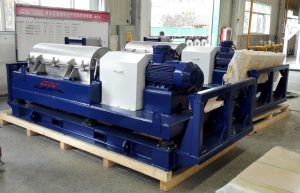In many industry applications, it is often the case that solids materials are mixed with liquid. For instance in water well drilling process there is a lot of slurry. Dumping will contaminate environment and waste a lot of water, and it may damage landscape. Under this circumstance, decanter centrifuge will play a very important role to separate solids from liquid. Without decanter centrifuge, solids/liquid separation will become low efficient, high cost and waste of liquid because of low separation efficiencies in other means of separation.
The mostly commonly used decanter centrifuge horizontal type. They work under the principle of gravitational separation. Let us take an example. If you fill a container with mud and liquid. The weight of the mud will cause it to settle down to the bottom of the container. The aggregation of the solids on the base of the container will force liquid to stay on top of the solids, generating a obvious barrier between solids and liquid. The longer the mud is undisturbed in the container, the clearer the liquid is.
Decanter centrifuge uses the same principle of gravitational force. The difference is that decanter centrifuge formulates a much stronger gravitational force, which is usually 500 to 5000 time the regular gravitational force, which greatly reduce the time for solids to settle down, and the sizes of smallest particles decanter centrifuge can remove.
Rotational separation can be found in many area, from amusement parks to country county ground. Rotating horizontally gives you a force to overcome gravitational force from the earth. Decanter centrifuge works the same way, except that the rotation can be vertical, causing solids to move in radial direction, not in horizontal direction as we see in amusement park. The other thing is that decanter centrifuge rotates in much higher RPM, usually in a few hundreds RPM. Small centrifuges can run at the speed of over 10,000 RPM.